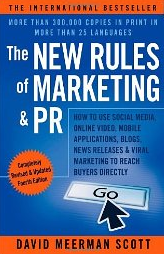I recently read “The New Rules of Marketing & PR: How To Use Social Media, Online Video, Mobile Applications, Blogs, News Releases & Viral Marketing To Reach Buyers Directly (3rd Edition)” by David Meerman Scott. Below are the quotes I found most interesting. As always, if you like the quotes, please buy the book here.
 “I’m absolutely convinced you will learn more by emulating successful ideas from outside your industry than by copying what your nearest competitor is doing.” (xxxii)
“I’m absolutely convinced you will learn more by emulating successful ideas from outside your industry than by copying what your nearest competitor is doing.” (xxxii)
“When people come to you online, they are not looking for TV commercials. They are looking for information to help them make a decision.” (4)
“Companies must tell their stories and spread their ideas online, at the precise moment that potential buyers are searching for answers.” (27)
“It is amazing that so many marketers don’t have established goals for their marketing programs and for websites and blogs in particular. And they often cannot articulate who their buyers are and what problems they solve for them.” (33)
“An effective web marketing and PR strategy delivers compelling content to buyers and gets them to take action.” (33)
“The Rules: Nobody cares about your product (except you)… No coercion required… Lose control… Put down roots… Create triggers that encourage people to share… Point the world to your (virtual) doorstep…” (100)
“Devoting attention to buyers and away from products is difficult for many people, but it always pays off in the form of bringing you closer to achieving your goals.” (137)
“For each buyer persona, we want to know as much as we can about this group of people. What are their goals and aspirations? What are their problems? What media do they rely on for answers to problems? How can we reach them? We want to know, in detail, the things that are important for each buyer persona. What words and phrases do the buyers use? What sorts of images and multimedia appeal to each? Are short and snappy sentences better than long, verbose ones?” (141)
“The typical website is one size fits all, with the content organized by the company’s products or services, not by categories corresponding to buyer personas and their associated problems.” (145)
“Figuring out the phrases for your market requires that you buckle down and do some research. Although interviewing buyers about their market problems and listening to the words and phrases they use is best, you can also learn a great deal by reading the publications they read.” (148)
“Don’t forget that different buyer personas buy different things from your organization.” (149)
“You’re writing for your buyers, not your own ego.” (151)
“When you stop talking about you and your products and services and instead use the web to educate and inform important types of buyers, you will be more successful.” (153)
“Remember that people don’t care about products and services; instead, they care about themselves and about solving their problems.” (166)
“The winner for the most overused word or phrase in 2008 was innovate which was used in 51,390 press releases, followed closely by unique, leading providers, new and improved, world class, and cost effective.” (181)
“Here’s a test: Take the language that the marketers at your company dreamed up and substitute the name of a competitor and the competitor’s product for your own. Does it still make sense to you? Marketing language that can be substituted for another company’s isn’t effective in explaining to a buyer why your company is the right choice.” (182)
“Talk to your audience as your might talk to a relative you don’t see too often – be friendly and familiar but also respectful.” (183)
“A digital community is awesome if you use it correctly. You don’t own it; you participate in it. You can’t buy it; you have to work at it. Be a good person, treat the world like you’d treat your family, and they’ll do the same.” (200)
“The easier you make a journalist’s job, the more likely she is to write about your organization, particularly when she is on a tight deadline.” (278)
“How to Pitch the Media: Target one reporter at a time… Help the journalist to understand the big picture… Explain how customers use your product or work with your organization… Don’t send email attachments unless asked… Follow up promptly with potential contacts… Don’t forget, it’s a two-way street – journalists need you to pitch them!” (293)
“Howe prefers to be pitched by email, with a subject line that helps him know it’s not spam. “ ‘PR pitch for Boston Globe Reporter Peter Howe’ is actually a very effective way to get my attention…If you simply put ‘Boston Globe Peter Howe’ into a google.com/news search and read the first 10 things that pop up, you would have done more work than 98 percent of the PR people who pitch me,” he says. “It’s maddening how many people in PR have absolutely no sense of the difference between what the Boston Globe covers and what, say, Network World or RCR Wireless News or the Nitwitville Weekly news covers. And I don’t mean to sound like a whining diva; the bigger issue is if you’re not figuring out what I cover and how before you pitch me, you are really wasting your own time.” (294-5)
“Search engine marketing is remarkable because, unlike almost every other form of marketing, it does not rely on the interruption technique.” (297)
“Search engine marketing programs often fail because the marketers optimize on general keywords and phrases that do not produce sufficiently targeted results.” (301)
“The best approach is to create separate search engine marketing programs for dozens, hundreds, or even tens of thousands of specific search terms that people might actually search on.” (302)
“Because the home page needs to serve many audiences, there can never be enough information there for each search term.” (304)
Liked the quotes? Buy the book here.

